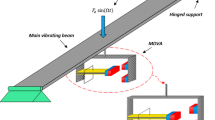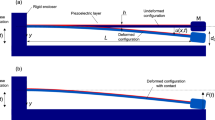Abstract
In this article, different approaches of the use of black box modelling techniques for piezoelectric actuators are particularly addressed, regardless of the employed technique/algorithm. A modelling approach in this paper refers to two matters: the first, the role of black box techniques in modelling (i.e. if physics-based techniques are also involved in modelling; if so, how and to what extent). From this aspect, the spectrum of approaches ranges from those merged with/inspired by classical phenomenological models to an approach based on purely system identification-based techniques. The second aspect of modelling approaches, in this article, is the input variables to the model. Current and previous values of input voltage, previous values of the output (displacement), derivatives and extremum values of the system's input/output have been used as the inputs to the model so far. Both aforementioned aspects of modelling approaches are addressed appropriately in this article, and various modelling approaches in the literature are categorized and presented in a uniform and comparable manner, so that readers can easily identify research trends in this area and the gaps in the literature. One of the identified unanswered questions in the literature is whether the extremum values of the system's input/output should/should not be used as an input to black box models of piezoelectric actuators. There are works in the literature which have/have not used the aforementioned input variables, but there is no published investigation to evidently answer the proposed question. This article, in the last section, answers this question by reporting and discussing an experimental study.
Similar content being viewed by others
References
Kozek M, Benatzky C, Schirrer A, Stribersky A (2011) Vibration damping of a flexible car body structure using piezo-stack actuators. Control Eng Pract 19(3):298–310. doi:10.1016/j.conengprac.2009.08.001
Masoy S-E, Standal O, Deibele JM, Nasholm SP, Angelsen B, Johansen TF, Tangen TA, Hansen R (2010) Nonlinear propagation acoustics of dual-frequency wide-band excitation pulses in a focused ultrasound system. J Acoust Soc Am 128(5):2695–2703. doi:10.1121/1.3488308
Polit S, Dong J (2011) Development of a high-bandwidth XY nanopositioning stage for high-rate micro-/nanomanufacturing. IEEE-ASME Trans Mechatron 16(4):724–733. doi:10.1109/tmech.2010.2052107
Satkoski C, Shaver G (2011) Piezoelectric fuel injection: pulse-to-pulse coupling and flow rate estimation. IEEE-ASME Trans Mechatron 16(4):627–642. doi:10.1109/tmech.2010.2048334
Thompson SJ, Doel P, Brooks D, Strangwood M (2009) A 1-metre Ni coated CFRP demonstrator for large deformable mirrors. Paper presented at the 1st Ao4elt Conference-Adaptive Optics for Extremely Large Telescopes
Zhang XL, Tan YH, Su MY, Xie YQ (2010) Neural networks based identification and compensation of rate-dependent hysteresis in piezoelectric actuators. Physica B 405(12):2687–2693. doi:10.1016/j.physb.2010.03.050
Soderkvist J (1998) Using FEA to treat piezoelectric low-frequency resonators. IEEE Trans Ultrason Ferroelectr Freq Control 45(3):815–823
Han JH, Cho KD, Youn SH, Lee I (1999) Vibration and actuation characteristics of composite structures with a bonded piezo-ceramic actuator. Smart Mater Struct 8(1):136–143
Wang G, Wereley NM (1998) Frequency response of beams with passively constrained damping layers and piezo-actuators. In: Davis LP (ed) Passive damping and isolation–smart structures and materials 1998, vol 3327. Proceedings of the Society of Photo-Optical Instrumentation Engineers (Spie). pp. 44–60
Boukari AF, Carmona JC, Moraru G, Malburet F, Chaaba A, Douimi M (2011) Piezo-actuators modeling for smart applications. Mechatronics 21(1):339–349. doi:10.1016/j.mechatronics.2010.12.005
Xie WF, Fu J, Yao H, Su CY (2009) Neural network-based adaptive control of piezoelectric actuators with unknown hysteresis. Int J Adapt Control Signal Process 23(1):30–54. doi:10.1002/acs.1042
Zhang JJ, Wang EC, Gao RZ (2008) Neural network predictive control for piezoelectric smart structures. In: Proceedings of the 9th Biennial Conference on Engineering Systems Design and Analysis-vol 2, Haifa, Israel, 2008. pp 417–421
Meeker TR (1996) Publication and proposed revision of ANSI/IEEE standard 176-1987 “ANSI/IEEE standard on piezoelectricity”. IEEE Trans Ultrason Ferroelectr Freq Control 43(5):717–718
Song DW, Li CJ (1999) Modeling of piezo actuator's nonlinear and frequency dependent dynamics. Mechatronics 9(4):391–410
Jung SB, Kim SW (1994) Improvement of scanning accuracy of PZT piezoelectric actuators by feedforward model-reference control. Precis Eng J Am Soc Precis Eng 16(1):49–55
Leigh T, Zimmrman D (1991) An implicit method for the nonlinear modelling and simulation of piezoceramic actuators displaying hysteresis. In: 112th ASME Winter Annual Meeting, Atlanta, USA, 1–6 December, 1991. pp. 57–63
Preisach F (1935) Uber die magnetische Nachwirkung. Z Phys 94:277–302
Ge P, Jouaneh M (1995) Modeling hysteresis in piezoceramic actuators. Precis Eng J Am Soc Precis Eng 17(3):211–221
Liaw HC, Shirinzadeh B (2011) Robust adaptive constrained motion tracking control of piezo-actuated flexure-based mechanisms for micro/nano manipulation. IEEE Trans Ind Electron 58(4):1406–1415. doi:10.1109/tie.2010.2050413
Zhang YD, Fang YC, Zhou XW, Dong XK (2009) Image-based hysteresis modeling and compensation for an AFM piezo-scanner. Asian J Control 11(2):166–174. doi:10.1002/asjc.092
Li C, Tan Y (2004) A neural networks model for hysteresis nonlinearity. Sens Actuators A Phys 112(1):49–54. doi:10.1016/j.sna.2003.11.016
Dupre L, Van Keer R, Melkebeek J (2001) Generalized scalar Preisach model for grain oriented materials excited along arbitrary directions. J Appl Phys 89(11):7245–7247
Ge P, Jouaneh M (1997) Generalized Preisach model for hysteresis nonlinearity of piezoceramic actuators. Precis Eng J Am Soc Precis Eng 20(2):99–111
Han Y, Zhu J (2009) Implementation procedure for the generalized moving Preisach model based on a first order reversal curve diagram. Rare Metals 28(4):355–360. doi:10.1007/s12598-009-0071-x
Yu YH, Naganathan N, Dukkipati R (2002) Preisach modeling of hysteresis for piezoceramic actuator system. Mech Mach Theory 37(1):49–59
Makaveev D, Dupre L, De Wulf M, Melkebeek J (2001) Modeling of quasistatic magnetic hysteresis with feed-forward neural networks. J Appl Phys 89(11):6737–6739
Sixdenier F, Scorretti R, Marion R, Morel L (2008) Quasistatic hysteresis modeling with feed-forward neural networks: influence of the last but one extreme values. J Magn Magn Mater 320(20):E992–E996. doi:10.1016/j.jmmm.2008.04.076
Ljung L (1999) System identification, theory for the user, 2nd edn. Prentice Hall, Upper Saddle River
Lin FJ, Shieh HJ, Huang PK (2006) Adaptive wavelet neural network control with hysteresis estimation for piezo-positioning mechanism. IEEE Trans Neural Netw 17(2):432–444. doi:10.1109/tnn.2005.863473
Lin FJ, Shieh HJ, Huang PK, Teng LT (2006) Adaptive control with hysteresis estimation and compensation using RFNN for piezo-actuator. IEEE Trans Ultrason Ferroelectr Freq Control 53(9):1649–1661
Yang XF, Li W, Wang YQ, Ye G (2008) Modeling hysteresis in piezo actuator based on neural networks. In: Kang L, Cai ZH, Liu Y (eds) Advances in computation and intelligence, Proceedings, vol 5370. Lecture Notes in Computer Science. pp 290–296
Deng L, Tan YH (2009) Modeling hysteresis in piezoelectric actuators using NARMAX models. Sens Actuators A Phys 149(1):106–112. doi:10.1016/j.sna.2008.09.022
Zhang XL, Tan YH, Su MY (2009) Modeling of hysteresis in piezoelectric actuators using neural networks. Mech Syst Signal Process 23(8):2699–2711. doi:10.1016/j.ymssp.2009.05.002
Ghaffari A, Mehrabian AR, Mohammad-Zaheri M (2007) Identification and control of power plant de-superheater using soft computing techniques. Eng Appl Artif Intell 20(2):273–287. doi:10.1016/j.engappai.2006.06.006
Jang JR, Sun C, Mizutani E (2006) Neuro-fuzzy and soft computing. Prentice-Hall of India, New Delhi
MathWorks (2011) Fuzzy Logic Toolbox™ user's guide
Dong RL, Tan YH, Chen H, Xie YQ (2008) A neural networks based model for rate-dependent hysteresis for piezoceramic actuators (vol 143, pg 370, 2008). Sens Actuators A Phys 148(1):350–351. doi:10.1016/j.sna.2008.05.001
Dang XJ, Tan YH (2007) RBF neural networks hysteresis modelling for piezoceramic actuator using hybrid model. Mech Syst Signal Process 21(1):430–440. doi:10.1016/j.ymssp.2005.09.016
Hwang CL, Jan C, Chen YH (2001) Piezomechanics using intelligent variable-structure control. IEEE Trans Ind Electron 48(1):47–59
Ying H (1998) General SISO Takagi-Sugeno fuzzy systems with linear rule consequent are universal approximators. IEEE Trans Fuzzy Syst 6(4):582–587
Ying H (1998) General Takagi-Sugeno fuzzy systems are universal approximators. 1998 IEEE International Conference on Fuzzy Systems at the IEEE World Congress on Computational Intelligence-Proceedings, vol 1–2
Chen TP, Chen H (1995) Approximation capability to functions of several variables, nonlinear functionals, and operators by radial basis function neural networks. IEEE Trans Neural Netw 6(4):904–910
Chen TP, Chen H (1995) Universal approximation to nonlinear operators by neural networks with arbitrary activation functions and its application to dynamical-systems. IEEE Trans Neural Netw 6(4):911–917
Chen TP, Chen H, Liu RW (1995) Approximation capability in C(R-N) by multilayer feedforward networks and related problems. IEEE Trans Neural Netw 6(1):25–30
Park J, Sandberg IW (1993) Approximation and radial-basis-function networks. Neural Comput 5(2):305–316
Liang JW, Chen HY, Chiang SY (2008) Precision control of a piezo-actuate system using fuzzy sliding-mode control with feedforward predictor-based compensation. In: Hwang SJ, Lee SY (eds) Advanced manufacture: focusing on new and emerging technologies, vol 594. Materials Science Forum. pp 401–406
Lin FJ, Shieh HJ, Huang PK, Shieh PH (2008) An adaptive recurrent radial basis function network tracking controller for a two-dimensional piezo-positioning stage. IEEE Trans Ultrason Ferroelectr Freq Control 55(1):183–198. doi:10.1109/tuffc.2008.627
Yang CH, Chang KM (2006) Adaptive neural network control for piezoelectric hysteresis compensation in a positioning system. 2006 IEEE International Symposium on Industrial Electronics, vols 1–7
Mayergoyz ID (1988) Dynamic Preisach models of hysteresis. IEEE Trans Magn 24(6):2925–2927
Serpico C, Visone C (1998) Magnetic hysteresis modeling via feed-forward neural networks. IEEE Trans Magn 34(3):623–628
Makaveev D, Dupre L, De Wulf M, Melkebeek J (2002) Isotropic vector hysteresis modeling with feed-forward neural networks. J Appl Phys 91(10):8322–8324. doi:10.1063/1.1456400
Zhang MM, Xu JZ (2011) Active control of fluctuating pressure induced by blade-vortex interaction. SCIENCE CHINA Technol Sci 54(4):862–868. doi:10.1007/s11431-010-4232-9
Zhang XL, Tan YH (2010) A hybrid model for rate-dependent hysteresis in piezoelectric actuators. Sens Actuators A Phys 157(1):54–60. doi:10.1016/j.sna.2009.10.009
Kosmatopoulos EB, Smyth AW, Masri SF, Chassiakos AG (2001) Robust adaptive neural estimation of restoring forces in nonlinear structures. J Appl Mech Trans Asme 68(6):880–893
Pei JS, Smyth AW, Kosmatopoulos EB (2004) Analysis and modification of Volterra/Wiener neural networks for the adaptive identification of non-linear hysteretic dynamic systems. J Sound Vib 275(3–5):693–718. doi:10.1016/j.jsv.2003.06.005
Nelles O (2001) Nonlinear system identfication. Springer, Berlin
Mohammadzaheri M, Chen L (2010) Intelliegnt predictive control of model helicopters' yaw angle. Asian J Control 12(6):1–13
Mohammadzaheri M, Chen L, Mirsepahi A, Ghanbari M, Prime Z (2010) Hybrid intelligent control of an infrared dryer. Paper presented at the 38th Austrlaian Conference of Chemical Engineering, Adelaide, Australia
Mohammadzaheri M, Chen L, Ghaffari A, Willison J (2009) A combination of linear and nonlinear activation functions in neural networks for modeling a de-superheater. Simulat Model Pract Theor 17(2):398–407. doi:10.1016/j.simpat.2008.09.015
Deng H, Li HX, Wu YH (2008) Feedback-linearization-based neural adaptive control for unknown nonaffine nonlinear discrete-time systems. IEEE Trans Neural Netw 19(9):1615–1625. doi:10.1109/tnn.2008.2000804
Mohammadzaheri M, Chen L, Grainger S (2014) A critical review of the most popular types of neuro control. Asian J Control 16(1):1–11
Author information
Authors and Affiliations
Corresponding author
Rights and permissions
About this article
Cite this article
Mohammadzaheri, M., Grainger, S. & Bazghaleh, M. A comparative study on the use of black box modelling for piezoelectric actuators. Int J Adv Manuf Technol 63, 1247–1255 (2012). https://doi.org/10.1007/s00170-012-3987-5
Received:
Accepted:
Published:
Issue Date:
DOI: https://doi.org/10.1007/s00170-012-3987-5




